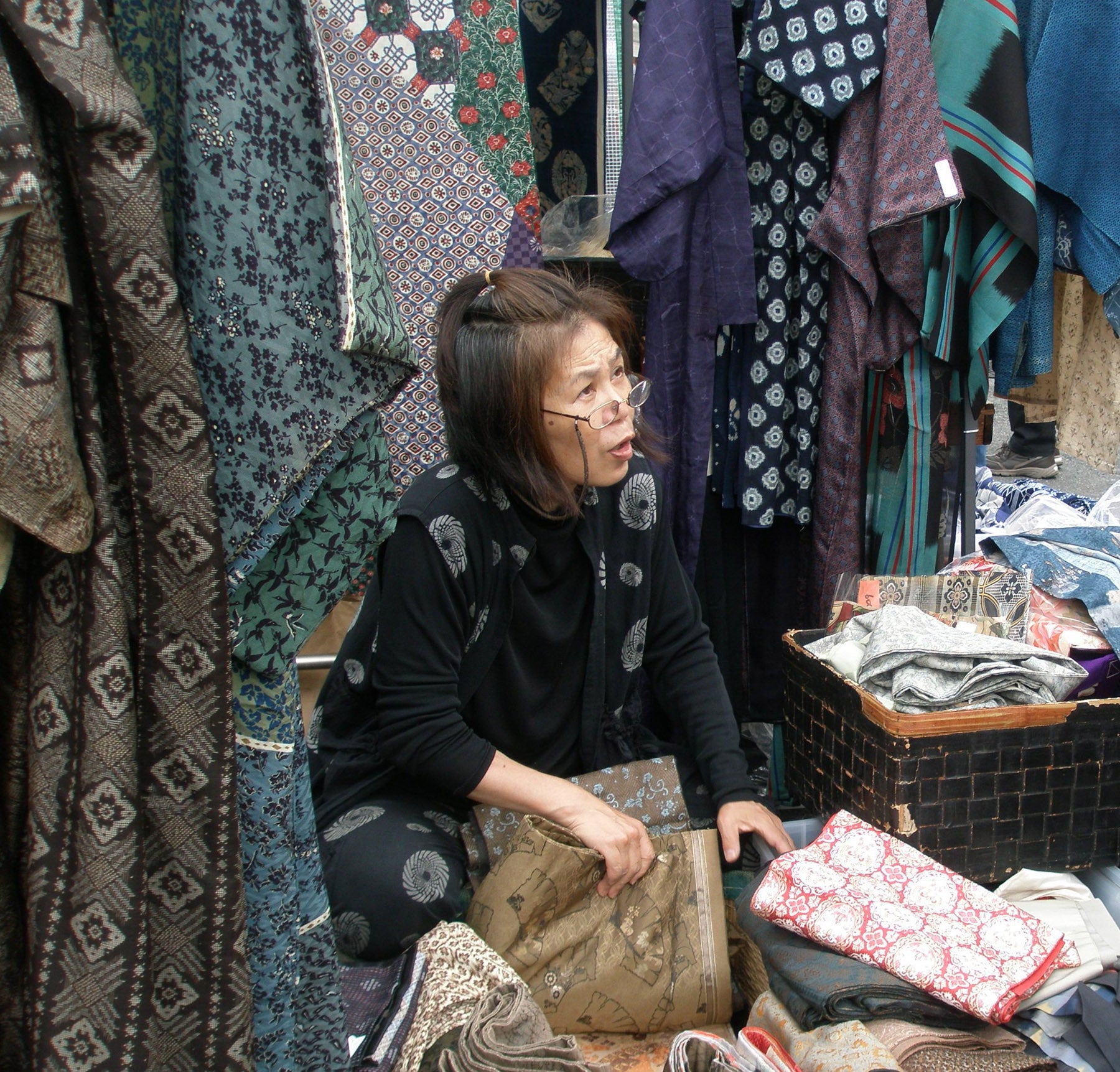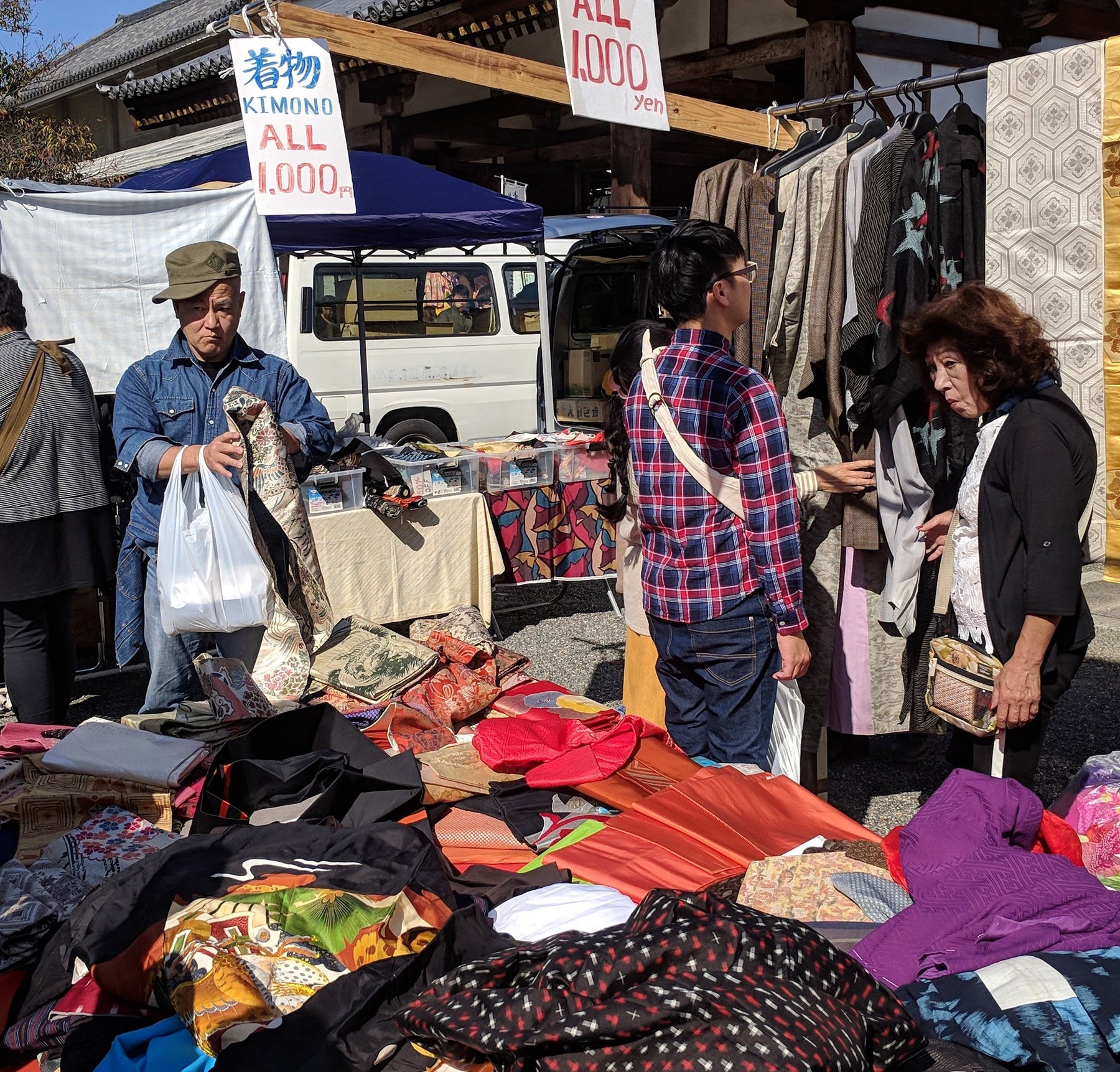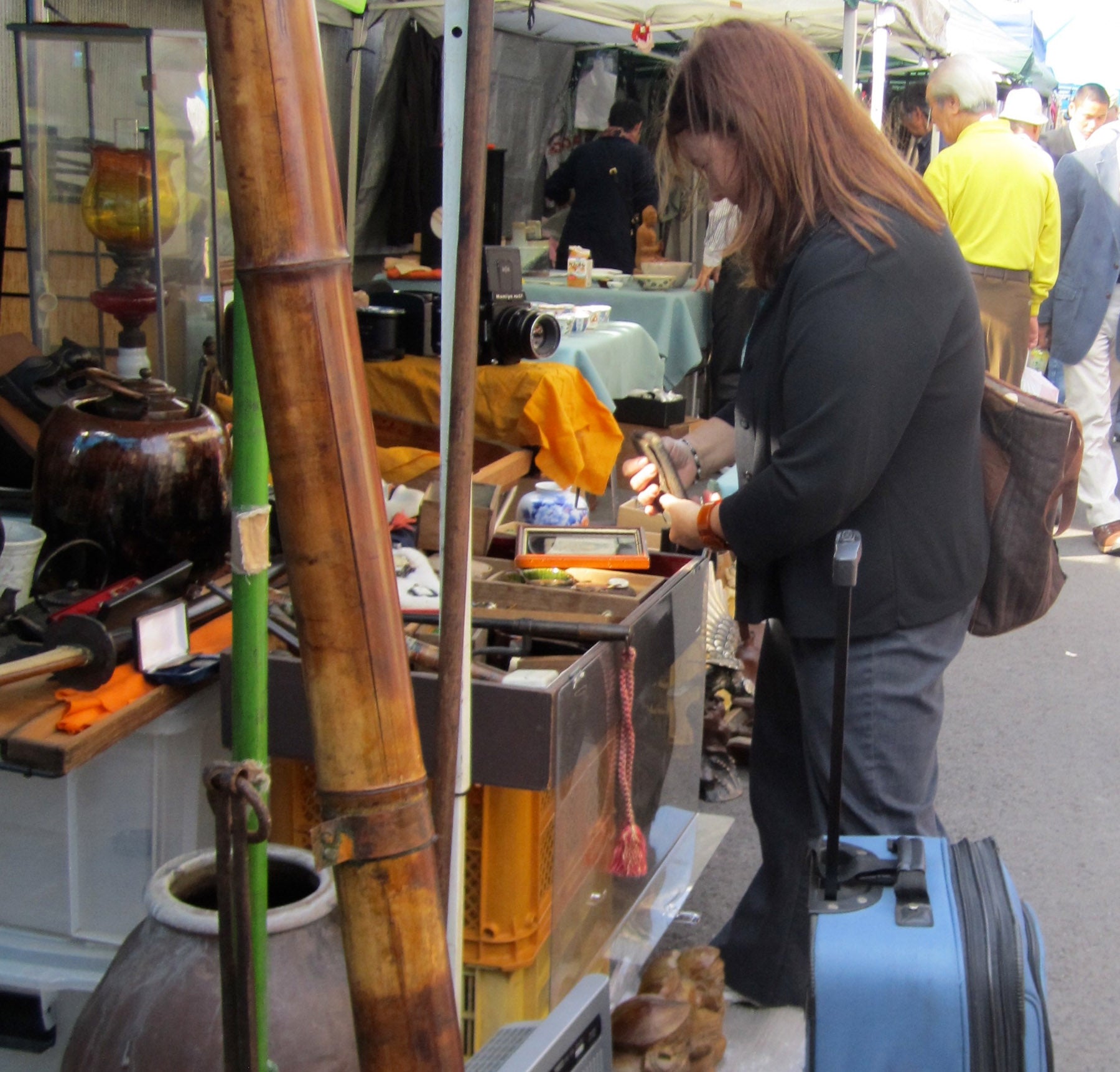Okan Arts Quilting & Textile Tours to Japan are open for booking. To learn more +click here
By guest blogger Nancy McDonough of Kyoto Kimono
ENDICOTT NY Ohaiyo gozaimasu! Greetings from Upstate New York.
When I lived in Kyoto for three years in the mid-1990s, I fell in love with Japanese textiles. Upon my return to the US, I started selling vintage Japanese garments and fabric, as well as a line of japanique apparel and accessories made from kimono.
About the same time I started Kyoto Kimono, I began leading tours to Kyoto each October. These tours get me back there once a year and refresh my love of Japanese culture as I see it anew through the eyes of my group members. The participants are all textile enthusiasts, and shopping for fabric and kimono is one of the highlights of the tour.
Shopping at Kyoto's Temple Markets

My favorite place to shop for kimono is at either of Kyoto's two big temple flea markets held each month: Toji on the 21st and Kitano on the 25th. Both are held rain or shine, from about 7am to 4pm. There are several hundred vendors at both markets offering antique, vintage and new items.

The temples are open during the markets so you will likely see devotees making incense offerings and praying. It may seem odd to Westerners that commerce and religion are happening simultaneously. Please remember to be respectful of these places despite the hustle and bustle of the markets.
Toji Temple on the 21st

The market at Toji Temple is also called Kobo-San. It is the larger of the two monthly markets. Toji Temple is located about a 15-minute walk to the southwest of the JR Kyoto Station, or a 5-minute walk from the Kintetsu Toji Station.
To get there, I take a taxi to the north gate to avoid crowds and to shop from the many great kimono sellers in this area.
I like to go at 7am – this is what the North Gate looks like at 7am:

This is what the market looks like by 10am:

Yes, it does get crowded on a sunny day at both markets!
Kitano-Tenmangu Temple on the 25th

The market at Kitano Temple is also called Tenjin-San. Although smaller, it could still take most of a day to see everything. Kitano Temple is located in a northwest neighborhood of Kyoto, accessible by bus or taxi (no nearby subway stop). The entrance is on the south side of the temple.
You'll find kimono vendors among the booths that line the pathway and street on the right side of the temple while gardening items, kids’ games, and food vendors are to the left.
Here are some suggestions that apply to either market.

What's for sale? Local Japanese still shop at these markets for everyday items—socks, tea, dried fruit, contemporary fabric—but the focus shifted decades ago to cater to the tourist market. So you'll also find crafters and artisans selling their work, individuals selling a mix of garage-sale-type items, importers offering craft items from Indonesia or Thailand, and so on. Plus there are usually two or three dozen vendors selling traditional Japanese textiles.

A few specialize in indigo or boro (antique patchwork), others in bolts and yardage, but most have hundreds of kimono, haori (kimono jackets), and obi (kimono belts) of every style, color, and season—which is what I go for.

Pricing: Kimono, haori, obi and fabric bolt pricing ranges from 500 yen (usually in a bargain bin out front) to 2000 yen (which are folded or piled high on ground cloths or low tables). You can find some pretty amazing pieces in the 500 yen bin, but many in this range are synthetic, damaged, or both (still good for piecework though).
Kimono that are hung up behind the vendor...

or still wrapped in washi paper...

are likely to be in the 8,000—10,000 yen range and up, and tend to be antique or very unique and usually worth the price.
Take cash: I've never met a vendor who takes credit cards, though it may be coming one day. Don't take more cash than you want to spend unless you are highly resistant to temptation. If you need cash, plan on using your debit card at any 7-11 convenience store or post office ATM before heading to the market – there aren't any nearby either temple.
Quality vs Quantity: While great bargains can be found, be sure to thoroughly examine textiles before you purchase. Low cost vintage textiles are usually blemished in some way—perhaps just a small spot or tear. Most are still wearable or make great display pieces. If you want "pristine", be prepared to pay for it.
Communicating: Most vendors know some English, but having an app like Google Translate on your phone can make things so much easier. I also highly recommend learning numbers in Japanese. When words fail, try using the Japanese hand signals for numbers (https://www.tsunagujapan.com/learn-the-japanese-gestures-for-counting/)

Haggling: Most vendors won't haggle unless you're buying several pieces or asking for a discount on an expensive item. By the same token, if you don't ask for a discount but purchase several things, they are likely to gift you something as a thank you. So if a seller puts an extra piece in your bag, smiles, and says sah-veese (service), you should say "Arigato" and smile back. Maybe even bow a little.
Roll, Don't Carry: Take a wheelie suitcase even if you don't think you're going to buy much. Textiles are heavy. Having a suitcase also shows the vendors you're a serious buyer.

Food: There's fun "festival" food at these markets, but the selection is somewhat limited. If you're not an adventuresome eater, you may have only a few options, such as fried chicken or yakisoba noodles.

If you like to try new things, I recommend okonomiyaki (the omelet-like dish shown below) and taiyaki (a warm, sweet, fish-shaped pancake filled with custard or red beans).

No Public Seating: Most food vendors have seating for customers only and there are no benches along the thoroughfare. You might find a shady ledge or concrete steps on the temple grounds, but there are no designated rest areas.

Bathrooms: Give yourself plenty of time to find the one and only toilet at each market. It's always recommended that you carry tissues and a small hand towel with you, as most Japanese do, especially at markets, festivals, and in non-touristy areas.
Do Visit Kyoto!

What a special place Kyoto is for anyone interested in Japanese culture. It's not just the famous castles and iconic shrines, the warmth and generosity of the people, the amazing clockwork precision of the culture, or the artistically presented food that make it captivating. It's the feeling of being in an almost magical place. It’s still a feeling I marvel at each time I am there.

So yes, go and shop, but don't miss an early morning moment at Ryoanji Zen Garden or a quiet stroll along Philosopher's Path.
Arigato gozaimashita!
To learn more about Nancy and Kyoto Kimono +click here









